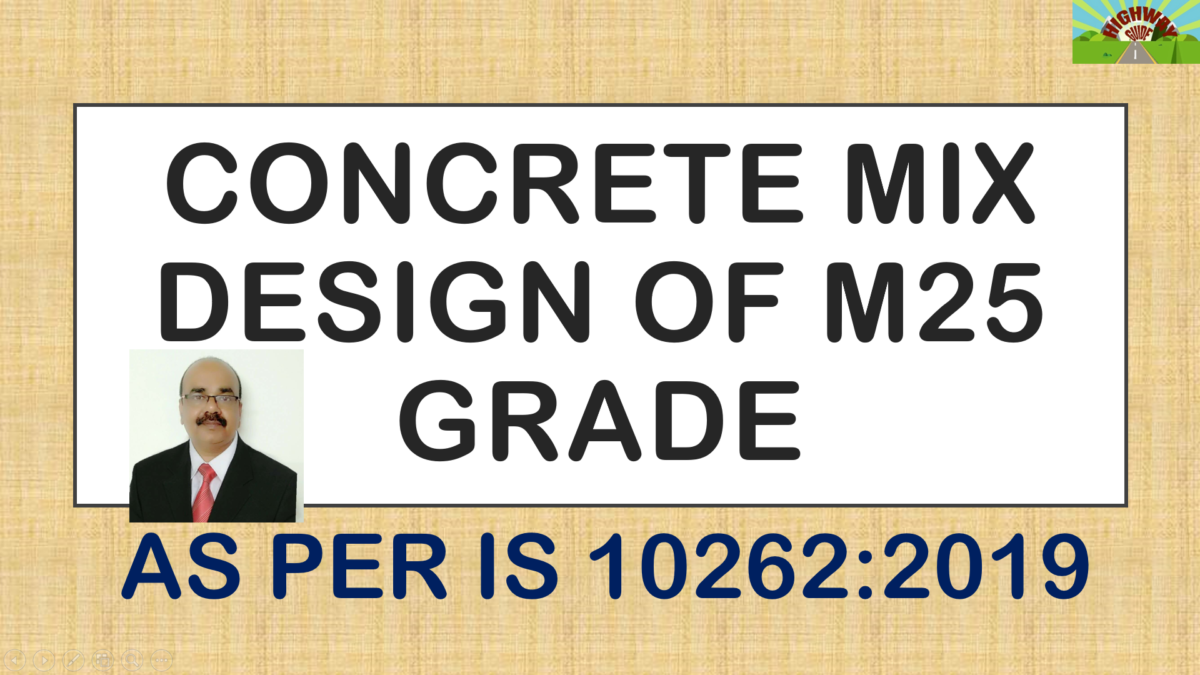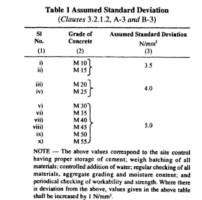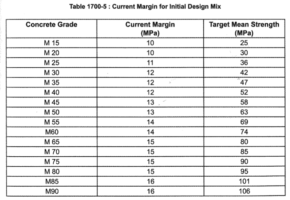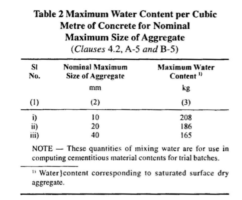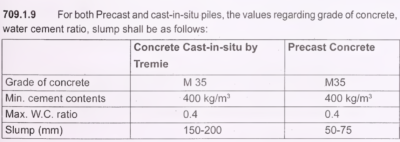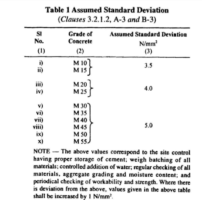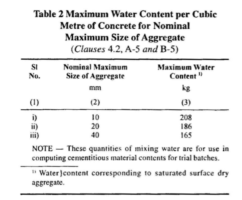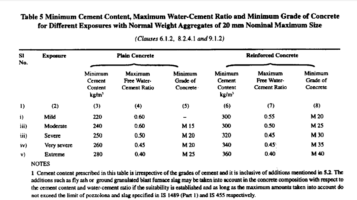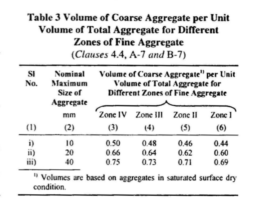1.STIPULATIONS FOR PROPORTIONING
a) Grade designation : M 25 RCC
b) Type of cement : 43 grade Ordinary Portland Cement conforming IS 8112
c) Maximum nominal size of coarse aggregate : 20 mm
d) Minimum amount of cement : 300 kg/m³ as per IS 456
e) Maximum water-cement ratio : 50 as per Table 5 of IS 456:2000
f) Workability : 75-125 mm slump
g) Exposure condition : Moderate (For Reinforced Concrete)
h) Method of concrete placing : Pumping
j) Degree of supervision : Good
k) Type of aggregate : Crushed Angular Aggregates
l) Chemical admixture type : Super Plasticizer Normet
2.TEST DATA FOR MATERIALS
a) Cement used : Sagar 43 grade Ordinary Portland cement conforming IS 8112
b) Specific gravity of cement : 3.14
c) Chemical admixture : Super Plasticizer conforming to IS 9103
d) Specific gravity of
1) Coarse aggregate 20 mm : 2.799
2) Coarse aggregate 10 mm: 2.789
3)Combined Specific Gravity of aggregate ( 20 mm- 60% & 10 mm 40 % )=2.795
4) Fine aggregate : 2.517
e) Water absorption:
1) Coarse aggregate 20 mm : 0.41 %
2) Coarse aggregate 10 mm : 0.59 %
3) Fine aggregate : 1.87 %
f) Aggregate Impact Value : 20.52%
g) Combined Flakiness & Elongation Index : 27.57 %
h) Sieve analysis:
1) Coarse aggregate: Conforming to all in aggregates of Table 2 of IS 383
2) Fine aggregate : Conforming to Grading Zone III of Table 4 of IS 383
3 TARGET STRENGTH FOR MIX PROPORTIONING
f’ck =fck + 1.65 s Or f’ck = fck + X where
f’ck = average target compressive strength of concrete at 28 days,
fck = characteristics compressive strength of concrete at 28 days,
X = Factor based on grade of concrete
S = standard deviation. From table 2 of IS 10262-2019 S = 4 N/mm² & from table 1 , X=5.5
Therefore target strength of concrete using both equation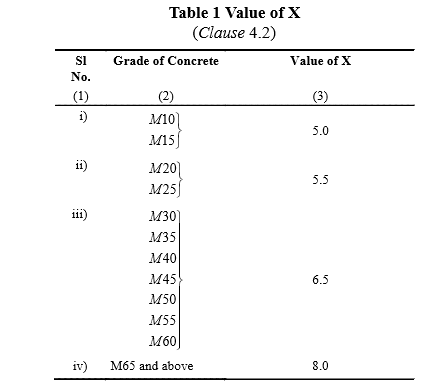
. 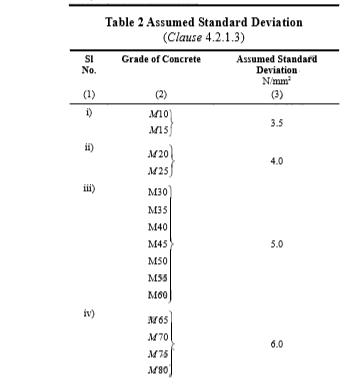
a) f’ck= fck+ 1.65 S = 25 + 1.65 x 4 = 31.60 N/mm²
b) f’ck = fck+ X = 25 + 5.5 = 30.5 N/mm².
The higher value to be adopted , therefore target strength will be 31.60 N/mm². Can adopt this value while doing the concrete mix design those who are working other than highway project.
But as per MORT&H Table 1700.5 required target mean compressive strength = 25 + 11 = 36.00 N/mm² where 11 is the current margin. Adopt this value those who are working in highway project.
4. APPROXIMATE AIR CONTENT
From Table 3, the approximate amount of entrapped air to be expected in normal (non-air-entrained) concrete is 1.0 percent for 20 mm nominal maximum size of aggregate.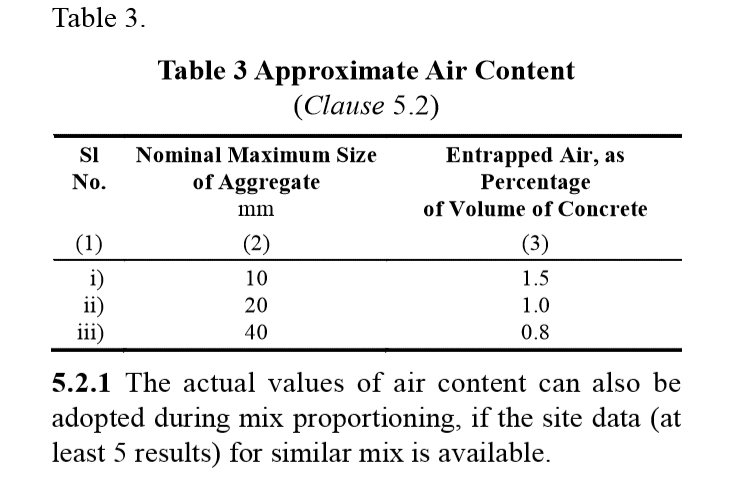
5 SELECTION OF WATER-CEMENT RATIO
From Fig. 1 of IS 10262 -2019, the free water-cement ratio required for the target strength of 31.60 N /mm² is 0.48 may be used for OPC 43 grade curve. (For other than MORT&H)
Maximum water cement ratio required for the target strength of 36.00 N /mm²(As per MORT&H requirement) is 0.44 from figure 1 of IS 10262-2019.
My suggestion & experience , never adopt higher water cement ratio because it is the main reason for cube failure at site. In IS code , suggestion has been given for adopting the water cement ratio but concrete designer has to take the decision what to keep water cement ratio.
Based on trial & experience adopted 0.44 water cement ratio.
This is lower than the maximum value of 0.50 prescribed for from the Table 3 of IS 456 maximum Water Cement Ratio for moderate condition
As per MORT&H, maximum water cement ratio is 0.45 for moderate condition so 0.44 is satisfying all codal provision whether it is IS 456 or MORT&H
0.44 < 0.50 < 0.45 hence ok.
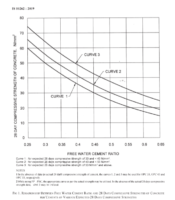
6. SELECTION OF WATER CONTENT
From Table 4 of IS 10262:2019, maximum water content for 20 mm aggregate = 186 liter (for 25 to 50 mm slump range)
but for an increase by about 3 percent for every additional 25 mm slump so here estimated water content for 125 mm slump
= 186+(9/100) x 186
= 202 liter.
Based on trials with Super plasticizer water content reduction of 23.76 % has been achieved . How it comes ,
We will see the back calculation
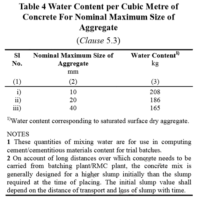
(Water requirement , if we intended to keep cement 350 kg & w/c ratio 0.44 for our concrete mix design calculated water will be 154 liter , so required reduction in water when using superplaticizer = 100 – (154/202 x 100) = 23.76 %.)
Net required water = 202 – (202 x 23.76) % = 202 – 48 = 154.0 litre
Note :For 75 mm slump increase 3% , for 100 mm increase 6% , increase 9 % for 125 mm slump, increase 12 % for 150 mm slump & increase 15 % for 175 mm slump
7 CALCULATION OF CEMENT CONTENT
As discuss earlier adopted based on trial w/c Ratio = 0.44
Cement Content = 154/0.44 = 350 kg/m³
,from Table 5 of IS 456, minimum cement content for ‘moderate’ exposure conditions is 300 kg/m³ but taken 350 kg/m³ > 300 kg/m³ hence ok.
As per MORT&H 5th revision for moderate exposure with reference to Table number 1700-2 maximum water cement ratio 0.45 & minimum cement 340 kg/m³ is specified but we had taken 350 kg/m³ , hence ok
but we had taken 350 kg/m³ > 340 kg/m³ hence ok.
8 PROPORTION OF VOLUME OF COARSE AGGREGATE AND FINE AGGREGATE CONTENT
As per table number 5 of IS 10262:2019 volume of coarse aggregate for 20 mm nominal size aggregate and fine aggregate (Zone III) for having water-cement ratio of 0.50 =0.64 (a)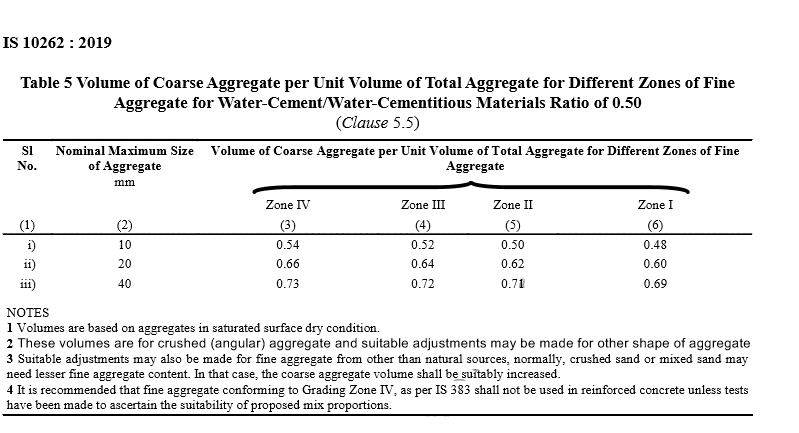
20 mm aggregate and fine aggregate (Zone III) for having water-cement ratio of 0.50 =0.64 (a)
In the present case water-cement ratio is 0.44. Therefore. volume of coarse aggregate is required to be increased to decrease the fine aggregate content. As the water-cement ratio is lower by 0.06. the proportion of volume of coarse aggregate is increased by 0.012 (at the rate of -/+ 0.01 for every ± 0.05 change in water-cement ratio).
= (0.06/0.05) = 1.2 times of 0.01 so 0.01 x 1.2 = 0.012 (b)
= a+b = 0.64 + 0.012 =0.65 (at the rate of -/+ 0.01 for every ± 0.05 change in w/c ratio).
Therefore, corrected proportion of volume of coarse aggregate for the water-cement ratio of 0.44 = 0.65
For pumpable concrete these values should be reduced up to 10%. Therefore, volume of coarse aggregate =0.65 x 0.9 =0.585 or say 0.59
Volume of fine aggregate content = 1 – 0.59 = 0.41
9 MIX CALCULATIONS
The mix calculations per unit volume of concrete shall be as follows:
a)Volume of concrete = 1 m³
b)Volume of the entrapped air in wet concrete =0.01m³
c) Volume of cement = [Mass of cement] / {[Specific Gravity of Cement] x 1000}
= 350/{3.15 x 1000} = 0.111 m³
d) Volume of water = [Mass of water] / {[Specific Gravity of water] x 1000}
= 154/{1 x 1000} = 0.154 m³
e) Base on trial we had kept admixture 50 percentage by weight of cement(You can increase % admixture dosage as per requirement)
Volume of admixture = [Mass of admixture ] / {[Specific Gravity of admixture ] x 1000}
= 1.75 /{1.090 x 1000}
= 0.0016 m³
f) Volume of all in aggregate = [(a-b)-(c+d+e)]
= [(1-0.01)-(0.111+0.154+0.0016)]= 0.99-0.250
= 0.723 m³
g) Mass of coarse aggregate= e x Volume of Coarse Aggregate x Specific Gravity of coarse Aggregate x 1000
= 0.723 x 0.59 x 2.795 x 1000
= 1192.26 kg/m³
h) Mass of fine aggregate= e x Volume of Fine Aggregate x Specific Gravity of Fine Aggregate x 1000
= 0.723 x 0.41 x 2.517 x 1000
= 746.11 kg/m³
10 MIX proportion
Cement = 350 kg/m³
Water = 154 l/m³
Fine aggregate = 746.11 kg/m³
Coarse aggregate 20 mm = 1192.26 x 60 %= 715.36 kg/m³
Coarse aggregate 10 mm = 1192.26 x 40 %= 476.90 kg/m³
Chemical admixture = 1.75 kg/m³
Water-cement ratio = 0.44
11 CALCULATION

1.Aggregate 20 mm = 715.26/ (1+(0.41/100)} = 712.0 kg
2. Aggregate 10 mm = 476.90/ (1+(0.59/100)} = 474.0 kg
3.Sand = 746.11/ (1+(1.87/100)} = 732.0 kg
4.Water = 2444 – 350 – 1.75 -732 -712 – 474 = 174.25 kg
Can say 174 kg alternatively can calculate in the following manner.
154+(746.11-732.0) +(715.26-712) +(476.90-474) = 154 + 14.11 + 3.26 + 2.90 = 174.27 or say 174 kg
Note 1.Do the trial in dry position as in practical in batching plant you can cot use aggregate in SSD condition.
2.Do the number of trials with variation of ± 10 percent of water-cement ratio & different cement content,
3.Do the surface moisture correction whenever required.

